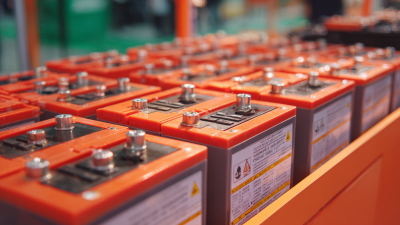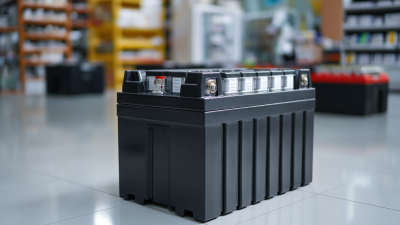Exploring the Future: Top 2025 Storage Batteries for Sustainable Energy Solutions
As the global demand for sustainable energy solutions continues to rise, the role of storage batteries in facilitating this transition becomes increasingly critical. According to a report by the International Energy Agency (IEA), energy storage capacity is projected to reach 1,200 gigawatt-hours by 2030, underscoring the pivotal importance of advanced battery technology in stabilizing renewable energy sources. In this context, the evolution of storage batteries is not only a technical challenge but also a vital component of our energy infrastructure.

As we explore the top storage batteries for 2025, it's essential to consider the advancements in lithium-ion technology as well as the emerging alternatives, such as solid-state and flow batteries. The World Economic Forum highlights that investments in storage batteries could exceed $100 billion by 2025, driven by innovations aimed at enhancing energy efficiency and longevity. This investment is poised to revolutionize how we harness solar, wind, and other renewable energies, providing grid stability and facilitating decentralized energy systems.
In this article, we will delve into the leading storage battery technologies projected to dominate the market in 2025, examining their performance metrics, sustainability profiles, and potential applications in various sectors. By understanding these developments, we can better appreciate how storage batteries will shape the future of energy consumption and contribute to a more sustainable planet.
Emerging Technologies Driving the Next Generation of Storage Batteries
The landscape of energy storage is transitioning rapidly, with emerging technologies set to define the next generation of storage batteries. According to a report by Allied Market Research, the global battery energy storage system market is projected to reach $28.82 billion by 2027, growing at a CAGR of 17.4% from 2020. This growth is driven by an increasing demand for sustainable energy solutions and advancements in battery technology.
One prominent technology on the horizon is solid-state batteries, which utilize a solid electrolyte instead of the conventional liquid-based ones. This innovation not only enhances safety by reducing flammability risks but also offers higher energy density. A recent study from BloombergNEF indicates that solid-state batteries could offer energy densities upwards of 500 Wh/l, compared to around 250 Wh/l for current lithium-ion batteries, potentially revolutionizing electric vehicle (EV) range and performance. Moreover, the development of sodium-ion batteries is gaining traction as a cost-effective alternative to lithium-ion systems, with researchers at the University of Texas projecting that they could significantly lower material costs, addressing supply chain concerns associated with lithium and cobalt.
The integration of artificial intelligence (AI) in battery management systems is another key trend. According to McKinsey, AI can optimize charging cycles and enhance the longevity of battery life by as much as 30%. As these technologies continue to evolve, the future of storage batteries appears bright, paving the way for more sustainable and efficient energy solutions.
Key Features to Look For in 2025’s Most Sustainable Energy Solutions
In 2025, the landscape of storage batteries is set to evolve significantly, focusing on sustainable energy solutions that cater to environmental needs. When exploring these innovative energy solutions, there are several key features to consider. First and foremost, the battery's energy density is crucial. High energy density means that batteries can store more energy in a smaller volume, making them ideal for applications ranging from electric vehicles to grid storage.
Another important feature is the cycle life of the battery. A longer cycle life translates into a prolonged lifespan, reducing the need for replacements and minimizing waste. Additionally, look for batteries that utilize sustainable materials, such as recycled components or biobased materials, which contribute to a lower environmental footprint.
**Tips:** When evaluating new storage technologies, prioritize those that offer modular design, allowing easy upgrades or repairs. This adaptability not only extends the usability of your energy storage system but also promotes a more sustainable approach. Keep an eye out for innovations in battery charging speeds, as faster charging can enhance convenience and overall efficiency, making sustainable energy solutions even more accessible.
A Comparative Analysis of Top Battery Chemistries for Energy Storage
As the world shifts toward sustainable energy solutions, the importance of efficient energy storage cannot be overstated. In the landscape of battery chemistries, lithium-ion batteries continue to dominate due to their high energy density and established production infrastructure. They are widely used in electric vehicles and consumer electronics. However, the search for alternatives that could offer lower environmental impacts and improved performance is intensifying.
 Solid-state batteries represent a promising innovation on the horizon. Utilizing a solid electrolyte instead of a liquid one, these batteries have the potential to increase safety and longevity while reducing the risk of overheating or fires. Furthermore, sodium-ion and flow batteries are gaining attention for their cost-effectiveness and scalability, making them suitable for grid-level energy storage. By comparing these top battery chemistries, it becomes clear that a diverse approach to energy storage will be essential in realizing a sustainable energy future, catering to various applications and environmental considerations.
Solid-state batteries represent a promising innovation on the horizon. Utilizing a solid electrolyte instead of a liquid one, these batteries have the potential to increase safety and longevity while reducing the risk of overheating or fires. Furthermore, sodium-ion and flow batteries are gaining attention for their cost-effectiveness and scalability, making them suitable for grid-level energy storage. By comparing these top battery chemistries, it becomes clear that a diverse approach to energy storage will be essential in realizing a sustainable energy future, catering to various applications and environmental considerations.
Investments and Innovations Shaping the Future of Battery Storage Systems
The future of battery storage systems is being dramatically shaped by a surge of investments and innovations that prioritize sustainability and efficiency. In 2025, advancements in battery chemistry, particularly the development of solid-state and flow batteries, promise to enhance energy density and safety while reducing costs. Companies are focusing on improving the lifecycle of batteries, ensuring that they can be recycled effectively and do not contribute to environmental degradation. This emphasis on sustainability is drawing significant interest from venture capitalists and governments alike, keen on funding the next generation of energy storage solutions.
Moreover, the integration of renewable energy sources with advanced battery technologies is paving the way for a more reliable electrical grid. Innovations in artificial intelligence and smart energy management systems are enabling real-time monitoring and optimization of energy storage, allowing for dynamic response to energy demand. As countries strive to meet carbon neutrality goals, the collaboration between tech firms and research institutions is vital for driving these innovations forward. The confluence of such investments and technological breakthroughs is set to redefine the landscape of energy storage, making it more accessible and eco-friendly for the future.
Exploring the Future: Top 2025 Storage Batteries for Sustainable Energy Solutions
| Battery Type | Energy Density (Wh/kg) | Cycle Life (Cycles) | Charging Time | Cost ($/kWh) | Sustainability Rating |
|---|---|---|---|---|---|
| Lithium-Ion | 150-250 | 500-2500 | 1-2 hours | 150-200 | High |
| Solid-State | 300-500 | 1000-5000 | 30 minutes - 2 hours | 200-300 | Very High |
| Flow Battery | 20-40 | 2000-5000 | 2-8 hours | 300-600 | Medium |
| Sodium-Ion | 100-150 | 1000-2000 | 1-3 hours | 100-150 | High |
| Lithium Iron Phosphate | 90-160 | 2000-5000 | 1-4 hours | 120-200 | Very High |
Challenges and Opportunities in the 2025 Storage Battery Market
The 2025 storage battery market presents a dynamic landscape filled with both challenges and opportunities. With the global cathode materials market projected to grow from USD 37.78 billion in 2025 to USD 65.15 billion by 2030 at an 11.5% CAGR, the demand for efficient and advanced battery materials is on the rise. As governments worldwide, particularly in India, implement supportive policies and incentives to bolster energy storage capacities, the stage is set for significant market expansion. However, battery operators in regions like the U.S. face declining revenues, necessitating an agile approach to maintain profitability amid transitioning energy market conditions.

In Europe, the burgeoning battery energy storage systems (BESS) market is being catalyzed by ambitious renewable energy goals, despite encountering operational and revenue hurdles. The necessity for storing renewable energy at scale poses a practical challenge that can be overcome with technological advancements and strategic investment. It is essential for industry stakeholders to adapt to evolving market dynamics by employing innovative strategies that address these challenges.
Tips: When exploring storage battery options, consider materials with high energy density to maximize performance and efficiency. Additionally, keeping abreast of regulatory developments can provide early insights into market shifts, allowing for informed investment decisions.
Related Posts
-

7 Secrets to Finding the Best Battery Shop for Your Needs
-

Ultimate Guide to Choosing the Best Battery: Key Factors When You Buy a Battery for Optimal Performance
-

Deep Cycle Car Battery Trends and Insights from 2025 China Import and Export Fair
-

Top 10 Battery Supply Trends Transforming the Energy Industry in 2023
-

The Untold Secrets of Lead Acid Batteries: Maximizing Efficiency and Longevity
-

Ultimate Guide to Choosing the Right UPS Battery for Your Needs
